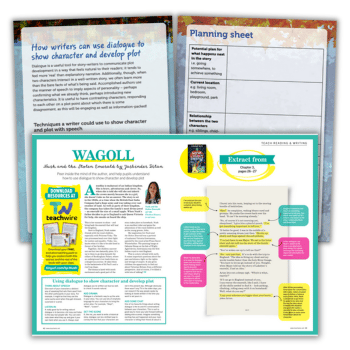Teach KS2 pupils to use dialogue to advance action by analysing a dramatic scene from Jasbinder Bilan’s novel, Nush and the Stolen Emerald.
It’s a story full of myth and it raises important questions about the past and shines a light on the rights and wrongs of empire.
It also gives children the opportunity to find out about Victorian Britain from a different perspective. And of course, it contains lots of talking!
This resource contains:
- Extract from Nush and the Stolen Emerald by Jasbinder Bilan
- ‘How writers can use dialogue to show character and advance plot’ poster
- ‘Exploring writers’ techniques’ worksheet
- ‘Exploring writers’ techniques’ working wall display
- Potential plan and contrasting character images
- Planning sheet
Your class will work towards planning and writing their own scene in which they use dialogue to develop character and plot.
Their challenge will be to contrast the two characters in the scene, in the way they behave and speak, while also introducing new plot points.
Using dialogue to advance action – KS2 tips
Think about speech
Give each of your characters a distinct way of speaking that sets them apart from the other participants in your story.
For example, it might be that they use the same quirky word when they get stressed, surprised or scared.
Listen in
A really good tip for writing natural dialogue is to become a bit nosy and listen to the way real people talk.
You can even note down what they say and give it your own twist when you use it. Always read dialogue you’ve written out loud as well, to check it sounds natural.
Add drama
Dialogue is a fantastic way to up the ante in your story. You can use lots of emphatic language for your characters to bring the action alive. For example, “Stop!”, “Wait!”, “Listen!”.
Set the scene
If, like me, you want to write a historical story, dialogue can be a brilliant way to convey the fact that your characters are not in the present day.
Although obviously there wasn’t any TV in the olden days, you can research the way people spoke by looking at novels written in the time you want to set yours in.
Add some chat
One of my favourite things about writing dialogue is the to-and-fro conversations between your characters.
This is such a good way to move your plot forward without adding extra scenes. Imagine something exciting has just happened and your main character is telling their friend all about it.
What is Nush and the Stolen Emerald about?
Anushka is maharani of an Indian kingdom. She is brave, adventurous and clever. So, when she is told she will she not inherit the crown merely because she is a girl, she doesn’t take no for an answer.
The story is set in the 1850s, at a time when the British East India Company had a huge army and was taking over vast swathes of land.
As well as parts of their kingdom, the company has taken the family’s most divine jewel – an emerald the size of a small apple.
When Nush’s father decides to go to England to ask Queen Victoria for help, she sneaks on board the ship. This is her moment to shine – and bring back the emerald that will heal the kingdom.
Once in England, Nush makes friends with the royal children, especially with Princess Vicky. The two princesses bond over their fight for justice and equality.
Vicky, too, knows what it’s like to be side-lined in favour of her brother. Together, the children uncover not one but two dastardly plots.
It’s up to them to go deep beneath the cellars of Buckingham Palace, where an underground river leads them on a dangerous journey.
It takes them to the backstreets of St Paul’s and a roof-top chase. The drama is laced with much excitement and a good part of the story takes place on horseback.
Nush is an excellent rider and gains the admiration of the royal children as well as the young groom, John.
My inspiration for Nush and the Stolen Emerald was a portrait of maharani Victoria Gowramma, painted by the royal artist Franz Xaver Winterhalter.
The painting hangs at Osborne House on the Isle of Wight. Aged eleven, Gowramma was the first Indian royal to visit England.
Thank you to Lindsay Pickton for creating the resource pack. Browse more WAGOLL packs from real authors.














